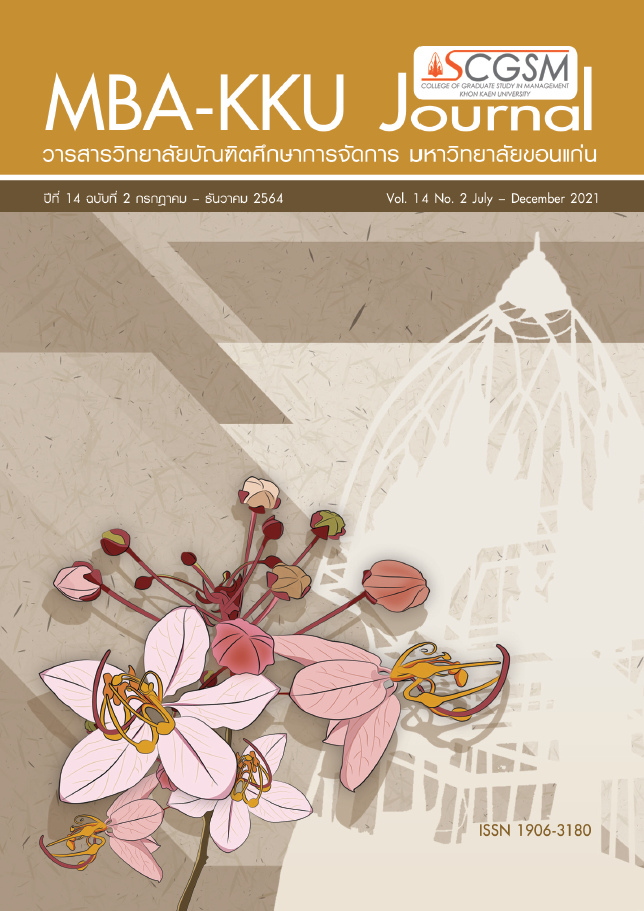Members Participation Model of Cluster Business Management: A Case Study of the Fashion and Lifestyle Cluster under the Federation of Thai Industry
Main Article Content
Abstract
The aims of this study were to investigate and identify the participation model of members in fashion and lifestyle cluster, the Federation of Thai
Industries and to identify the strategies for member participation in cluster business management. Data for this qualitative study were collected through interviews with 36 committee members of nine industry groups. Interview data
were then used to analyze the participation model using a diamond model, SWOT, and TOWS Matrix analyses, with results supporting the development
of a participation mode. The results showed that first, the model of member participation in the business group was the industry group representative system, in which one member is elected as serve on the Cluster Management Committee as per the regulations of the Federation of Thai Industries. The Cluster Management Committee is responsible for organizing activities, preparing meeting agendas, and informing and inviting general members to participate in the cluster activities. Second, while the analysis of relevant member participation models in the Fashion and Lifestyle Cluster suggested that the cluster member participation was limited by the regulations of the Federation of Thai Industries, members had the opportunity to independently
seek cooperation across industries, as appropriate, in relation to the supply chain. Finally, based on the examination of member participation strategies
in business management cluster, four sub strategies were found, including 1) proactive strategies emphasizing participation in supply chain and cluster product promotion activities with the government sector, 2) passive strategies
focusing on new market-seeking activities and negotiations with financial institutions in the public and private sectors, 3) corrective strategy supporting negotiations with government to resolve trade privileges with trading partners, and 4) preventive strategies to identify new sources of raw materials and propose business projects for government funding.
Article Details

This work is licensed under a Creative Commons Attribution-NonCommercial-NoDerivatives 4.0 International License.
- The ideas and opinions expressed in MBA-KKU Journal are those of the authors and not necessarily those of the editor.
- Copyright on any open access article in a journal published by MBA-KKU Journal
References
ติน ปรัชญพฤทธิ์. (2553). ทฤษฎีองค์การ. (พิมพ์ครั้งที่ 5). กรุงทพฯ: อินทภาษ.
เศรษฐภูมิ เถาชารี. (2558) การบริหารแบบมีส่วนร่วม. วารสารอินดัสเตรียลเทคโนโลยี รีวิว, 21 (276), 114-120.
วันชัย โกลละสุต. (2549). ความหมายและความสำคัญของการบริหารแบบมีส่วนร่วม. ค้นเมื่อ 16 กันยายน 2561, จาก www.kmcenter.rid.go.th
สภาอุตสาหกรรมแห่งประเทศไทย. (2562). เกี่ยวกับสภาอุตสาหกรรมฯ. ค้นเมื่อ 3 กรกฎาคม 2562, จาก https://www.fti.or.th/2016/thai/ftiaboutfti.aspx
American Public Transportation Association. (2019). The Role of Transit in Support of High Growth Business Clusters in the U.S. ค้นเมื่อ 3 กันยายน 2562, จาก https://www. apta.com/wp-content/uploads/Resources/resources/ reportsandpublications /Documents/TransitHighGrowthClustersUS-Final2013-1124-1.pdf
Asian, I., Kumpikaite, V. and Cinar, O. (2012). Creating strategies from tows matrix for strategic sustainable development of Kipaş Group. Journal of Business Economics and Management, 13(1), 95-110.
BOP Consulting (2017). The East London Fashion Cluster. Strategy and Action Plan, February 2017, 1-12.
Inter-American Development Bank. (2017). Cluster in the Caribbean. ค้นเมื่อ 30 กันยายน 2562, จาก https://pdfs.semanticscholar.org/ea7a/77c86e15c61fcbc46f0bef11e8f 3fce79b64.pdf.
Kulshrestha, S. & Puri, P. (2017). Tows Analysis for Strategic Choice of Business Opportunity and Sustainable Growth of Small Businesses. Pacific Business Review International, 10(5), 144-152.
Maxwell Stamp Plc. (2013). Support to Cluster Development in Croatia: Cluster Development Handbook. ค้นเมื่อ 12 ธันวาคม 2562, จาก https://www.enterprise-development.org/wp-content/uploads /GuidelinesforClusterDevelopment.pdf
Mefford, C. (2010). Washington State Fashion and Apparel Industry Cluster Study. Fashion and Apparel Industry Cluster Study, October 2010, 1-37
Porter, Michael E. (1998) Clusters and the New Economics of Competition Documentation. Harvard Business Review, November – December 1998 (Reprint 98609), 77-90.
Porter, Michael E. (1998). The Competitive Advantage of Nation. Harvard Business Review, Boston.
Swansburg, R. C. (1996). Management and leadership for nurse managers, 2nd edition. Boston: Jones and Bartlett.
The U.S. Agency for International Development (USAID). (2003). Software/ICT Cluster Strategy. Vietnam Competitiveness Initiative (VNCI), May 2003, Pp. 1-42.
Weihrich, H. (1982). The TOWS matrix-A tool for situational analysis. Long Range Planning, 15(2), 54-66.
Zhang, Z., To, C. & Cao, N. (2004). How do Industry Cluster Success: A Case Study in China’s Textiles and Apparel Industries. Journal of Textile and Apparel, Technology and Management, 4(2), 1-10.


